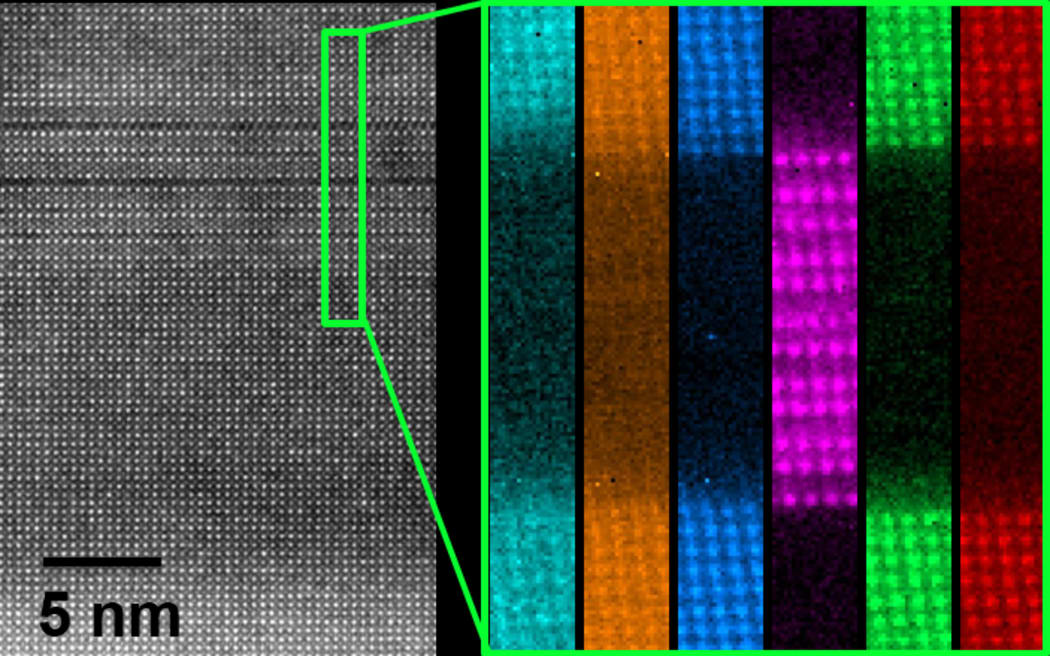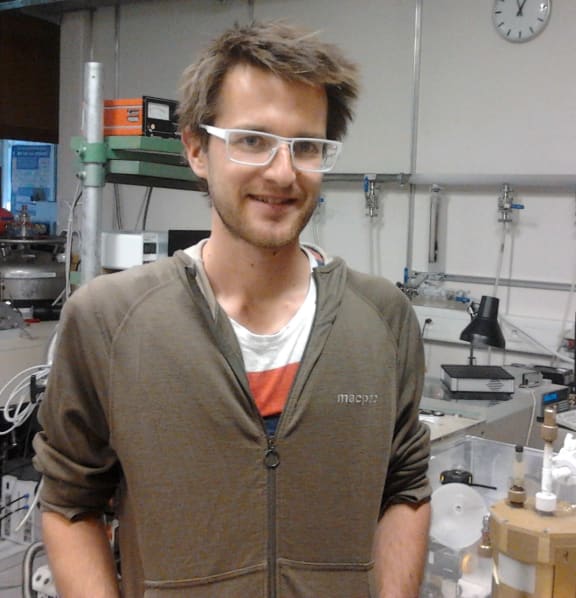‘Superconductor sandwiches’ sound like the latest lunch craze, but they are actually a physics experiment. And University of Auckland physicist Ben Mallett believes they could be part of an exciting future for high-temperature superconductors.

A 'superconductor sandwich' as seen under a high-power electron microscope. The dots are rows of atoms, neatly stacked atop each other. The coloured region at right is a close-up of part of the black-and-white area. The layers are colour coded to differentiate different elements. The superconductor layer is coloured purple. Photo: Ben Mallett / University of Auckland
Subscribe to Our Changing World for free on Apple Podcasts, Spotify, Stitcher, RadioPublic or wherever you listen to your podcasts
Superconductors are well-known for their ability to conduct electricity without any resistance, which means no power is lost along the way.

Physicist Ben Mallett, from the University of Auckland. Photo: University of Auckland
Rutherford Postdoctoral Fellow Ben Mallett, from the University of Auckland, the MacDiarmid Institute for Advanced materials and Nanotechnology and the Dodd-Walls Centre for Photonic and Quantum technologies, says “this is a unique property of matter, that to date only happens at low temperatures.”
The most common use of superconductors, says Ben, is to make very powerful magnets, such as those used in MRI machines in hospitals.
He says very large superconductor magnets are also in use at the large Hadron Collider at CERN, where the Higg’s particle was famously discovered in 2012.
When he started working in this field of physics, Ben was amazed to discover that most elements can become superconductors if they are cooled to sufficiently low temperatures, and in some cases, low pressure.
“This means it is quite a common state of matter,” says Ben. “Quite unique, but also common. But the particularly useful superconductors we are just starting to develop and produce on a mass scale are a mixture of metals and oxygen. And again, they were quite a surprise when we discovered that they were actually very useful.”
High temperature versus low temperature superconductors
An example of the new generation of useful high temperature superconductor materials is the ceramic compound YBCO, made from a mix of yttrium barium and copper oxide.
Now, 'high temperature' is a relative term. The first superconductors to be discovered were low temperature superconductors that need to be cooled to below minus 240°C. This requires expensive liquid helium.
But high temperature superconductors, such as YBCO, work at relatively balmy temperatures, warmer than minus 196°. The record for the highest temperature to date is a superconductor made from hydrogen sulphide that works at minus 70°. These temperatures can be achieved with liquid nitrogen – which is much cheaper, and more practical for industrial use.
New Zealand is a world-leader in high temperature superconductor research. In 2009, Bob Buckley and Jeff Tallon, from the Robinson Research Institute at Victoria University of Wellington, won the inaugural Prime Minister’s Science Prize for their work in this area. One of their major discoveries was another key superconductor called BSCCO (pronounced biss-co), that is made up of bismuth, strontium, calcium and copper oxide.
As well as making powerful magnets for things like MRI machines, high temperature superconductors are used for levitating Maglev trains, and they could transform our national electricity grid, as power cables and for making highly efficient electricity transformers.
Making sandwiches
In his own research, Ben is looking at the interaction between superconductors and magnetic materials.
“I call them 'superconductor sandwiches',” says Ben, “because I make a sandwiched layer with a superconductor in the middle and a magnetic material on either side. And you get qualitatively new behaviour when you do this.”
Ben says these ‘sandwiches’ are nano-sized, and “thin enough that you can actually count the number of atoms in each layer.”
The most exciting thing, though, is not their size, but an apparent contradiction. Superconductors are used to build powerful magnets, but “universally, superconductor properties get worse in a magnetic field,” says Ben
In Ben’s superconductor sandwiches, however, the properties of the superconductor get better when it is exposed to a magnetic field.
“It’s a complete surprise,” says Ben. “I thought the data were completely wrong when I first saw them. And we’re only just beginning to understand why they have this qualitatively new behaviour.”
Ben says there is still lots of work to be done to understand the properties of superconductor sandwiches, and he doesn’t know exactly how they might end up being used, although he says there is exciting work currently being done with high temperature superconductors in the emerging field of quantum computing.


